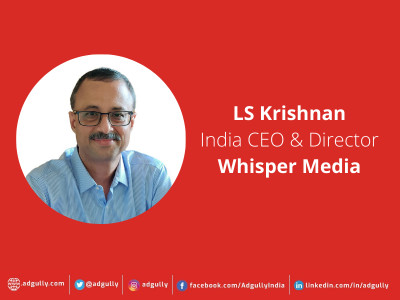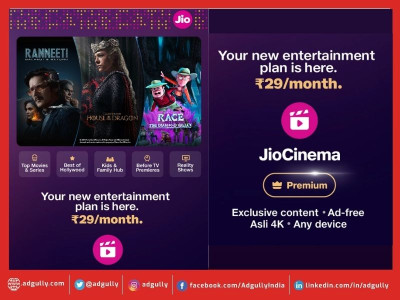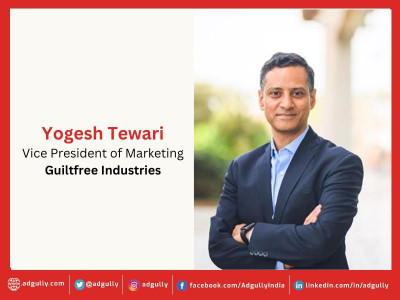“More market segmentation will give advertisers more opportunities to leverage TVâ€
Whisper Media has revolutionised the manner in which complex product placements and brand integrations can now be delivered in a simplified, fast-paced, scalable, and accountable manner using technology. Whisper Media has already partnered with ZEE and Star Network in India and has worked with over 100 brands in FY21. The company has achieved exponential growth, especially in the second half of FY21, and looks forward to exponential growth in FY22.
In conversation with Adgully, LS Krishnan, India CEO & Director, Whisper Media, speaks at length about the company's association with ZEE and Star, In-Content advertising, how consumer habits have changed and much more.
About Whisper Media’s association with ZEE and Star India, LS Krishnan said, “If you look at the journey, we are about three-year-old now, of which 2 years have been during the pandemic. I think that the Star Network and Zee Network believe that this is a format which has a future, and they have given continued support in terms of expanding into multiple markets with most clients. Because this is a relationship which is symbiotic in the sense that the pricing is done for every client specially customised and we need support from the broadcasters, and that’s been there with us for about three years, and we see the growth happening.”
Speaking about the growth roadmap for Whisper Media till now he shared, “We have been growing at 100% year-on-year per year despite the pandemic. I think we will continue with that growth percentage for the next couple of years. Last year, we did 150+ campaigns in 2021 despite COVID, we’ve got 75+ brands to come across categories from FMCG, consumer durables to retail brands. We have offices in Bangalore, Chennai, Delhi, Mumbai, which are large markets. We have about 13 channels that we handle across the two networks, and we have 78+ programs that we have to offer, so there is a huge market that people can address through Whisper Media’s ICA to efficiently integrate their message into the content.”
Explaining about how the pandemic impacted Whisper Media and the challenges faced, he said, “The pandemic actually hit us much harder than what we imagined, for the simple reason that the discretionary money or even energy to do something new came down dramatically because we were in the first year of operations when the pandemic came. For us, it was more awareness to be done, more acceptance to be gotten from the advertisers, that was not coming in right. But since October of last year, multiple brands have used ICA. And I think 30% to 40% of them are repeat clients in our current business; and we have large corporations who are now coming onboard with us. The face of business perspective is that it is a new concept and new format. And it takes time and effort for somebody to kind of move away from the status quo and try something new. We invest a lot of money on the research side to demonstrate ROI for brands. We do something called Viewability, which is to see what’s the percentage of users who have seen the ad, and how much time they spent looking at the ad. The other is the BLI brand studies that we do for most of our brands. That demonstrates the value proposition much more deeply, and therefore critical to get the business. So, the challenge that I see is the ability to try something new, which I think as months go by and years go by, it will become much easier as compared to the initial years.”
Adding on the challenges they face while offering this premium form of advertising in India, he said, “Anything that is new, has a lot of questions and doubts, whether it is effective or not. The other formats or something people have accepted; they know they are comfortable with it. So, that was a challenge for us. But our whole focus has been on building credibility and doing good execution. We truly believe that if you can do a good job on the execution front, then there is comfort. And one of the largest challenges is how seamlessly you can integrate, how can I know how we do not take too much of effort put in by the agencies and the brand teams. So, we have a seamless workflow, which once you have approved the campaign, at a creative level, then it gets executed. And at the touch of a button, they will get all the data on how each spot has done. So, I think the challenge was to kind of get somebody to use it once, and then have the comfort and ensure that we do a good job. That’s how we are building credibility for our clients.”
When asked about the role that In-Content Advertising plays in the evolving media universe, he explained, “The point is very simple, we sell attention for the advertisers. A TVC has an ability to tell a story, and in our format, given that we can only do one integration, or one ICA in 10-15 minute episode, it gives the brand a mindspace to communicate. And what our format does is to kind of reiterate some of the key features of the brand communication. So, we truly believe that the TVC has an ability to tell a story and ICA has an ability to kind of reiterate some of the key propositions for the brand communication. Both together become an important combination for a TV format, and, therefore, they're able to build effectiveness of the brand communication on TV a lot more. So, that’s our proposition. And I think, across many parts of the world, we have brought the business to scale. And for most of the branches in conventional TVC campaigns, it also helps them to get higher recall for TV spots. In the evolving landscape I think, given that TV is kind of having competition with the digital landscape. This format also helps TV to get a larger foothold in the budget of the advertisers, and that's one new format being offered to the advertisers. It helps to even get the broadcasters to get additional revenue from the advertisers.”
Giving his views on how the media landscape and customer habits have changed, especially in the last two years, he said, “Content consumption has changed, and more on the digital side. The new formats have come to take some part of the time spent on television, but I feel that India has still a long way to go to become a huge OTT consumer, because there is a cost of bandwidth. Linear TV is by far cost effective in terms of the cost per month. So, I think TV will continue to have a place of its own and even the market would need a global reach for any of these campaigns across target markets which is effective, but the landscape is changing because people will have more money or spend more time with OTT platforms. So, I think there will be more segmentation of the market and I think that will also kind of give advertisers more opportunities to leverage TV.”


















Share
Facebook
YouTube
Tweet
Twitter
LinkedIn